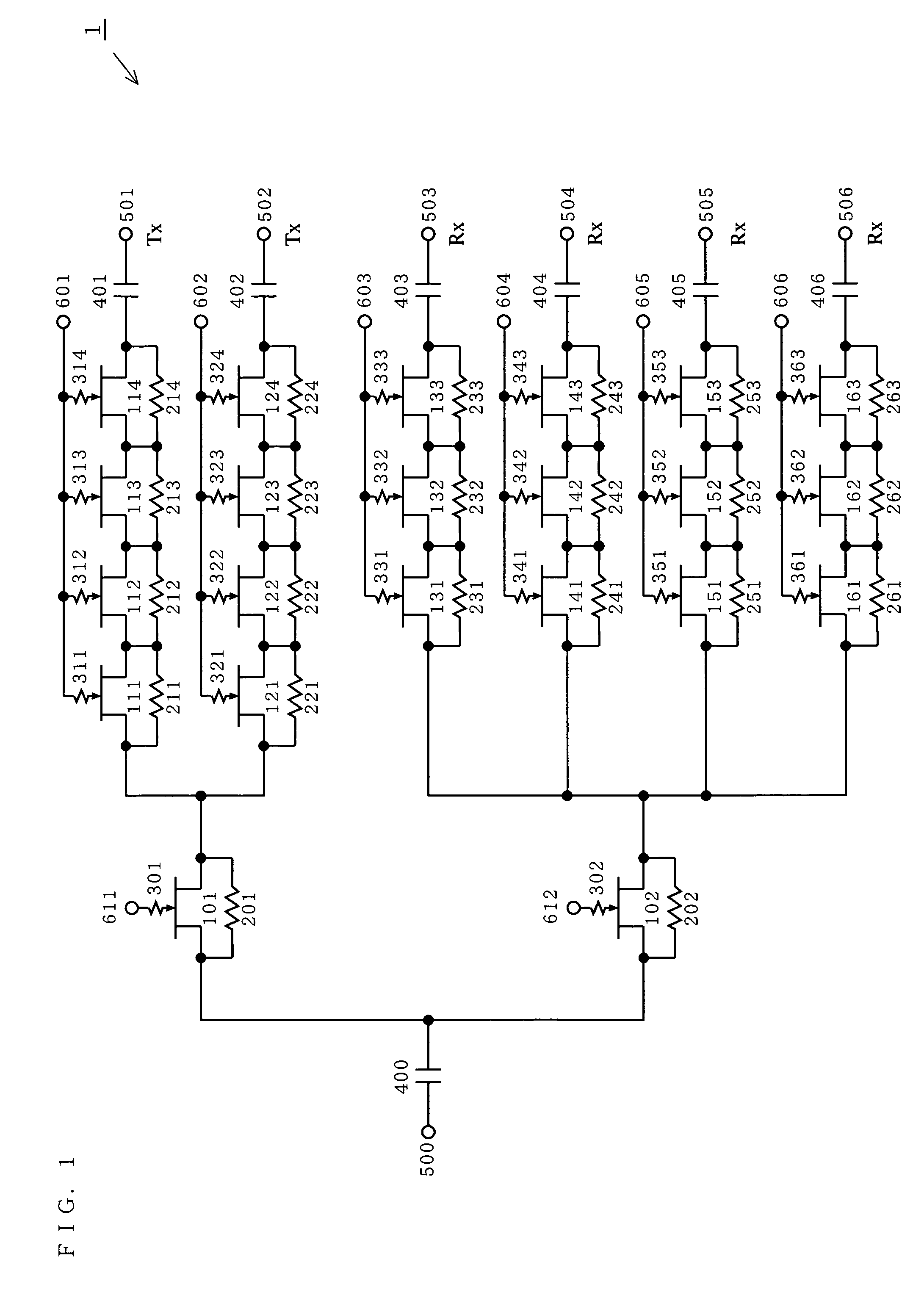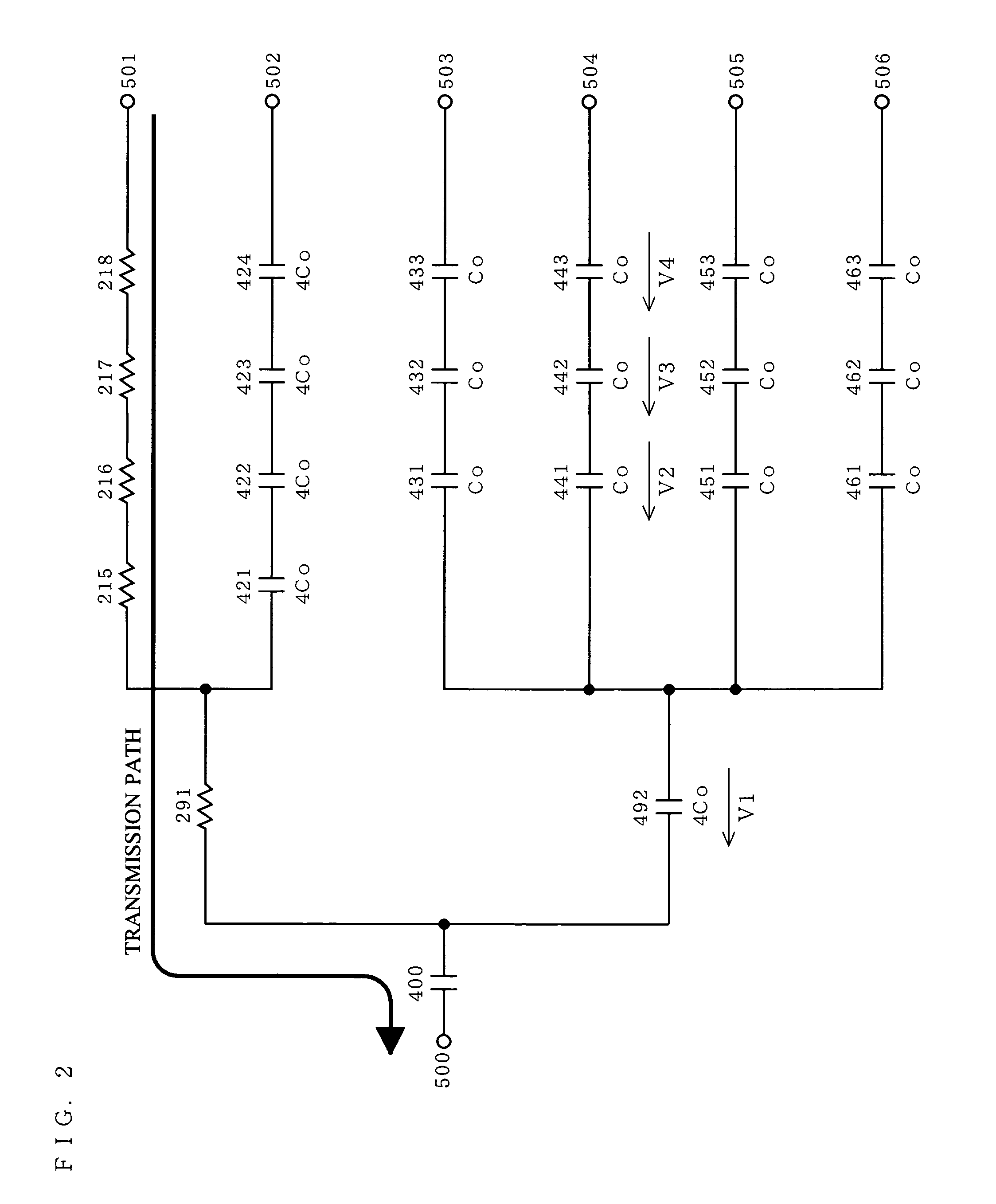Radio-frequency switching circuit and semiconductor device
a technology of radio frequency switching and semiconductor devices, applied in the direction of electronic switching, semiconductor devices, pulse techniques, etc., can solve the problems of increasing insertion loss, and deterioration of radio frequency characteristics, so as to improve insertion loss, improve frequency characteristics, and efficiently use shunt circuits
- Summary
- Abstract
- Description
- Claims
- Application Information
AI Technical Summary
Benefits of technology
Problems solved by technology
Method used
Image
Examples
first embodiment
[0046]FIG. 1 shows a configuration of a radio-frequency switching circuit 1 according to a first embodiment of the present invention. The radio-frequency switching circuit 1 comprises: FETs 101, 102, 111 to 114, 121 to 124, 131 to 133, 141 to 143, 151 to 153 and 161 to 163; resistors 201, 202, 211 to 214, 221 to 224, 231 to 233, 241 to 243, 251 to 253, 261 to 263, 301, 302, 311 to 314, 321 to 324, 331 to 333, 341 to 343, 351 to 353 and 361 to 363; capacitors 400 to 406; a common terminal 500; independent terminals 501 to 506; and control terminals 601 to 606, 611 and 612. In the present embodiment, the independent terminals 501 and 502 are transmission terminals TX, and the independent terminal 503 to 506 are reception terminals RX. The FETs are used as switching elements.
[0047]The common terminal 500 is connected to a drain of each of the FETs 101 and 102 via the capacitor 400. The FETs 101 and 102 respectively have drains and sources thereof connected via the resistors 201 and 202...
second embodiment
[0064]FIG. 7 shows a configuration of a radio-frequency switching circuit 2 according to a second embodiment of the present invention. The radio-frequency switching circuit 2 according to the second embodiment comprises: FETs 101 to 104, 111 to 114, 121 to 124, 131, 132, 141, 142, 151, 152, 161 and 162; resistors 201 to 204, 211 to 214, 221 to 224, 231, 232, 241, 242, 251, 252, 261, 262, 301 to 304, 311 to 314, 321 to 324, 331, 332, 341, 342, 351, 352, 361 and 362; capacitors 400 to 406; a common terminal 500; independent terminals 501 to 506; and control terminals 601 to 606 and 611 to 614.
[0065]As shown in FIG. 7, the radio-frequency switching circuit 2 according to the second embodiment has a configuration which is a result of replacing the FETs 133, 143, 153 and 163 and resistors 233, 243, 253, 263, 333, 343, 353 and 363 of the radio-frequency switching circuit 1 according to the first embodiment with the FETs 103 and 104, resistors 203, 204, 303 and 304 and control terminals 61...
third embodiment
[0068]FIG. 8 shows a configuration of a radio-frequency switching circuit 3 according to a third embodiment of the present invention. The radio-frequency switching circuit 3 according to the third embodiment comprises: FETs 101, 102, 111 to 114, 121 to 124, 131 to 133, 141 to 143, 151 to 153 and 161 to 163; resistors 201, 202, 211 to 214, 221 to 224, 231 to 233, 241 to 243, 251 to 253, 261 to 263, 301, 302, 311 to 314, 321 to 324, 331 to 333, 341 to 343, 351 to 353 and 361 to 363; capacitors 400 to 406, 471 and 472; a common terminal 500; independent terminals 501 to 506; and control terminals 601 to 606, 611 and 612.
[0069]As shown in FIG. 8, the radio-frequency switching circuit 3 according to the third embodiment has a configuration which is a result of adding capacitances 471 and 472 as reactance circuits to the radio-frequency switching circuit 1 according to the first embodiment. Since a fundamental function and effect of the radio-frequency switching circuit 3 are same as thos...
PUM
 Login to View More
Login to View More Abstract
Description
Claims
Application Information
 Login to View More
Login to View More - R&D
- Intellectual Property
- Life Sciences
- Materials
- Tech Scout
- Unparalleled Data Quality
- Higher Quality Content
- 60% Fewer Hallucinations
Browse by: Latest US Patents, China's latest patents, Technical Efficacy Thesaurus, Application Domain, Technology Topic, Popular Technical Reports.
© 2025 PatSnap. All rights reserved.Legal|Privacy policy|Modern Slavery Act Transparency Statement|Sitemap|About US| Contact US: help@patsnap.com



